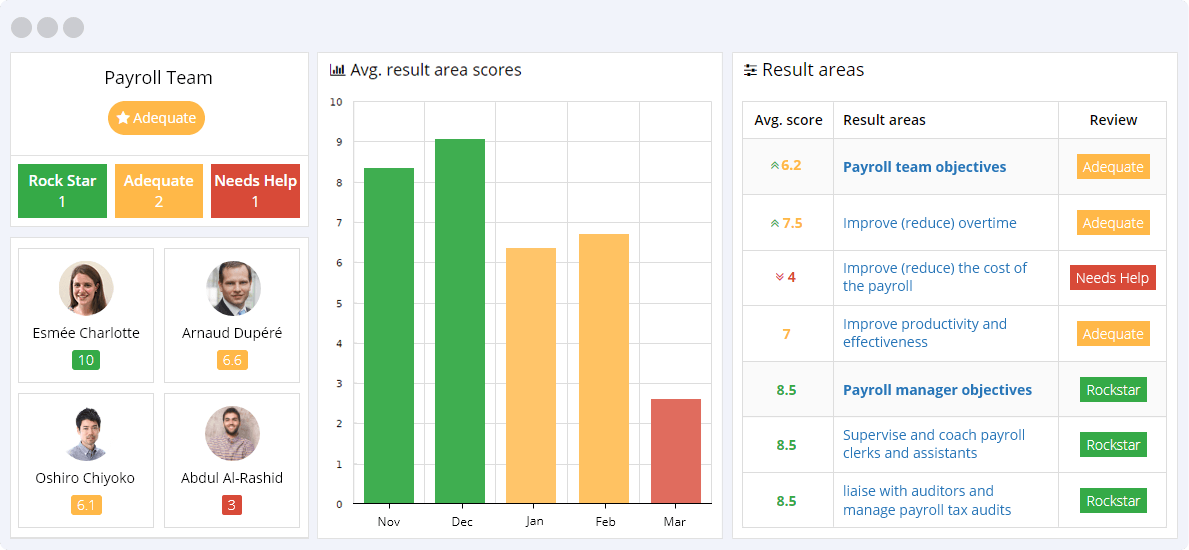Payroll Team Objectives
The payroll team objectives or KPIs are designed to track and measure the payroll team’s operational efficiencies, including elements such as reducing payroll costs, improving productivity and effectiveness, reducing overtime hours worked, and maintaining payroll information by designing systems and directing the collection, calculation, and entering of data.
- Improve (reduce) the cost of the payroll – This KPI tracks and measures the payroll team’s ability to improve or reduce the overall cost of running the payroll over time. The higher this metric, the greater the extent to which the payroll team is able to improve or reduce the payroll running costs over time.
- Improve productivity and effectiveness – This KPI tracks and measures the extent to which the payroll team is able to improve its productivity and effectiveness over time. The higher this metric, the greater the payroll team’s ability to improve its productivity and effectiveness over time.
View all
- Improve (reduce) overtime – This KPI tracks and measures the payroll team’s ability to improve or reduce the number of hours worked overtime. The higher this metric, the greater the payroll team’s productivity and efficiency, reducing the number of overtime hours worked.
- Improve (reduce) employee time required to complete a task – This KPI tracks and measures the extent to which the payroll team improves or reduces the employee time required to complete a task. The higher this metric, the greater the payroll team’s ability to reduce the time needed to complete a task.
- Local versus global payroll – This KPI tracks and measures the payroll team’s ability to balance the local versus the global payroll over time. The higher this metric, the greater the extent to which the payroll team is able to balance the local versus the worldwide payroll over time.
View less
Payroll Employee Objectives
The payroll employee objectives or KPIs are designed to track and measure the payroll employee operational efficiencies, including aspects like improving leave metrics, reducing the number of errors, reducing the time spent working on the payroll, and contributing to the team effort by designing systems to improve operations.
- Improve employee leave – The payroll employees must take their leave before it expires. This KPI tracks and measures the payroll employee’s ability to use up their leave on time. The higher this metric, the greater the payroll employee’s efficiencies.
- Improve (reduce) the number of errors – This KPI tracks and measures the extent to which the payroll employee is able to improve or reduce the number of errors when completing a task. The higher this metric, the greater the payroll employee’s ability to reduce the number of errors over time.
View all
- Improve (reduce) human errors in the payroll – This KPI tracks and measures the payroll employee’s ability to improve or reduce human errors in the payroll. The higher this metric, the greater the extent to which the payroll employee is able to reduce human errors when running the payroll.
- Improve (reduce) the time spent on the payroll – This KPI tracks and measures the extent to which the payroll employee is able to improve or reduce the time spent on the payroll. The higher this metric, the greater the payroll employee’s ability to enhance or reduce the time spent on the payroll.
- Improve Business Intelligence (BI) coordination with Human Resources (HR) – This KPI tracks and measures the extent to which the payroll employee is able to improve Business Intelligence (BI) coordination with Human Resources (HR) over time. The higher this metric, the greater the payroll employee’s ability to improve Business Intelligence (BI) coordination with Human Resources (HR) over time.
- Balances the payroll accounts by resolving payroll discrepancies – This KPI tracks and measures the extent to which the payroll employee is able to balance the payroll accounts by resolving payroll discrepancies. The higher this metric, the greater the payroll employee’s ability to balance the payroll accounts over time.
- Contribute to team effort by accomplishing related results as needed – The KPI tracks and measures the extent to which the payroll employee is able to contribute to the team effort by accomplishing related results as needed. The higher this metric, the greater the payroll employee’s ability to contribute to the team effort by accomplishing related results as needed.
View less
Payroll Manager Objectives
The payroll manager or employee objectives are designed to track and measure payroll manager operational efficiencies like optimizing training costs, improving team task productivity, coordinating timekeeping and payroll systems, supervising and coaching payroll clerks and assistants, liaising with auditors and managing payroll tax audits, and preparing reports as required.
- Improve training costs – Training is vital to ensure increased productivity and payroll team efficiencies. This KPI tracks and measures the payroll manager’s ability to improve or optimize payroll team and employee training costs. The higher this metric, the greater the payroll manager’s operational efficiencies.
- Improve the task productivity of the team – This KPI tracks and measures the payroll manager’s ability to improve the task productivity of the team. The higher this metric, the greater the extent to which the payroll manager is able to improve the team’s task productivity over time.
View all
- Coordinate timekeeping and payroll systems – This KPI tracks and measures the extent to which the payroll manager is able to coordinate timekeeping and payroll systems over time. The higher this metric, the greater the payroll manager’s ability to coordinate timekeeping and payroll systems over time.
- Supervise and coach payroll clerks and assistants – This KPI tracks and measures the extent to which the payroll manager is able to supervise and coach payroll clerks and assistants over time. The higher this metric, the greater the payroll manager’s ability to supervise and coach payroll clerks and assistants over time.
- Liaise with auditors and manage payroll tax audits – This KPI tracks and measures the payroll manager’s ability to liaise with auditors and manage payroll tax audits. The higher this metric, the greater the extent to which the payroll manager is able to liaise with auditors and manage payroll tax audits.
- Collaborate with Human Resources (HR) and accounting teams – This KPI tracks and measures the extent to which the payroll manager is able to collaborate with Human Resources (HR) and accounting teams. The higher this metric, the greater the payroll manager’s ability to collaborate with Human Resources (HR) and accounting teams over time.
- Prepare reports by compiling summaries of earnings, taxes, deductions, leave, disability, and nontaxable wages – This KPI tracks and measures the payroll manager’s ability to prepare reports by compiling summaries of earnings, taxes, deductions, leave, disability, and nontaxable wages. The higher this metric, the greater the extent to which the payroll manager is able to prepare reports as needed.
- Maintain employee confidence and protects payroll operations by keeping information confidential – This KPI tracks and measures the payroll manager’s ability to maintain employee confidence and protect payroll operations by keeping information confidential. The higher this metric, the greater the extent to which the payroll manager is able to maintain employee and protect payroll operations.
- Complete operational requirements by scheduling and assigning employees; following up on work results – This KPI tracks and measures the extent to which the payroll manager .is able to complete operational requirements by scheduling and assigning employees; following up on work results. The higher this metric, the greater the payroll manager’s ability to complete operational requirements by scheduling and assigning employees
View less
These payroll KPIs are an integral part of ensuring that the payroll team meets its key efficiencies and critical organizational goals. The successful implementation of an effective payroll strategy plays a vital role in ensuring that the company meets its operational and administrative goals. As a result, measuring these objectives is key to operational success. These KPIs focus on tracking metrics grouped in three result areas: employee, team, and manager.
It is critical to track and measure these KPIs over time because they offer insight into the payroll department’s successes and where improvements are needed. Metrics like reducing the payroll cost, improving team and individual productivity and effectiveness, optimizing or improving training costs, reducing the time spent on the payroll, and balancing the global versus the local payroll, are fundamental to ensuring the company’s operational success.
Implementing payroll KPIs or objectives for the payroll team, employee, and manager drives the obligation to guarantee consistency over time. High-performing metrics are valued, translating into an effective payroll management strategy and application thereof by the payroll team, manager, and employee. On the other hand, low-performing metrics must be revisited as they show poor performance and detract from operational and organizational success metrics.

